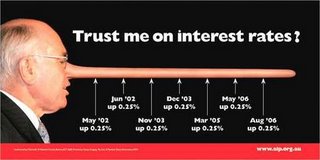
According to the definition by the US Centre for Media and Democracy in it’s SourceWatch www.sourcewatch.org/, an attack advertisement is a short, 15-60 second piece of political advertising usually on the electronic media and almost always aired during an electoral campaign, but maybe as a third party ad. It is a key feature of negative advertising and is often used to discredit a political figure or message. An attack ad is negative advertising but it also consitutes a new form of advertising, using some of the elements found in propaganda.
The most recent examples are those which have been used by both parties and independents during the recent mid-term elections in the United States and in Australia by the Labour Party, as part of an advertising campaign criticising Prime Minister John Howard’s trustworthiness and honesty over interest rates. There is also some talk attack advertising will be a feature of some of next year's State elections in Australia by the Labour Party.
The current campaign features billboards and commercials which portray John Howard as Pinocchio (see picture), whose nose has grown longer with each of the past seven interest rate rises. The campaign mocks his 2004 election pledge "to keep interest rates at record lows" and asks: "Who do you trust now?"
Common features of such an attack ad include conceptual metaphors that can serve to smear opponents (hence John Howard as Pinocchio), memorable sound bites intended to be repeated by the public on the street and in discussions about how to vote and to avoid libel claims, using deliberate ambiguity, fatuous and extreme assertions, which go beyond legal liability
All of this can also be delivered with a degree of humour.
So if the attack ad fails, an attack ad campaign can be "spun" into "good fun" by simply extending the conceptual metaphors or extreme assertions to humorous lengths.
Attack ads utilise a variety of familiar propaganda techniques to influence opinions. Attack ads may be presented through a variety of broadcast or print sources but usually are intended to deliver a specific message to a select audience. Rather than support a position held by the advertiser, attack messages target an opponent's platform, track record, background or character.
But for an attack ad to be really effective, the message probably needs to be believable. Repulsive imagery conveyed in attack ads might reinforce allegations or mask outright character attacks. The ads often rely on the resonance of the message to attract the attention of target audience members to a message most other listeners or viewers will ignore.
Let’s judge later the effectiveness of current attack advertising after the US mid-terms and maybe even see if Australian Prime Minister John Howard starts to develop a credibility gap. But according to Wikipedia http://en.wikipedia.org/wiki/Attack_ad some believe that attack ads are useful in shaping public opinion with some analysts claiming the effects can be as great as five percent change. However, it’s a fine line if an attack ad may fail in its intended purpose and backfire against the group which first used it. For example, if an ad is seen as going too far or being too personal the voters will turn against the party that put out the ad. There will be examples of this to be found in the mid-terms.
In the US, research has consistently found that negative advertising has positive effects. Finkel and Greer (1998) said negative advertising “is likely to stimulate voters by increasing the degree to which they care about the election’s outcome or by increasing ties to their party’s nominee.” This is an important feature of negative campaign advertising because it can solidify a candidate's support going into an election. The finding was repeated by Goldstein and Freedman (2002), who found that negative campaign ads raise interest in the election as well as raise the perceived importance of the election, which increases voter turnout (an important factor in non-compulsory US voting).
Here at DIFFUSION we don’t expect attack advertising to remain the sole property of political parties and their advertising agencies or even of political campaigners. What we see is the wider application of attack advertising into more general fields, designed to attack competitors or to dispute product or service claims. Either way, the ground has been established for their use and their effectiveness to mobilise a purchase decision has been proven.